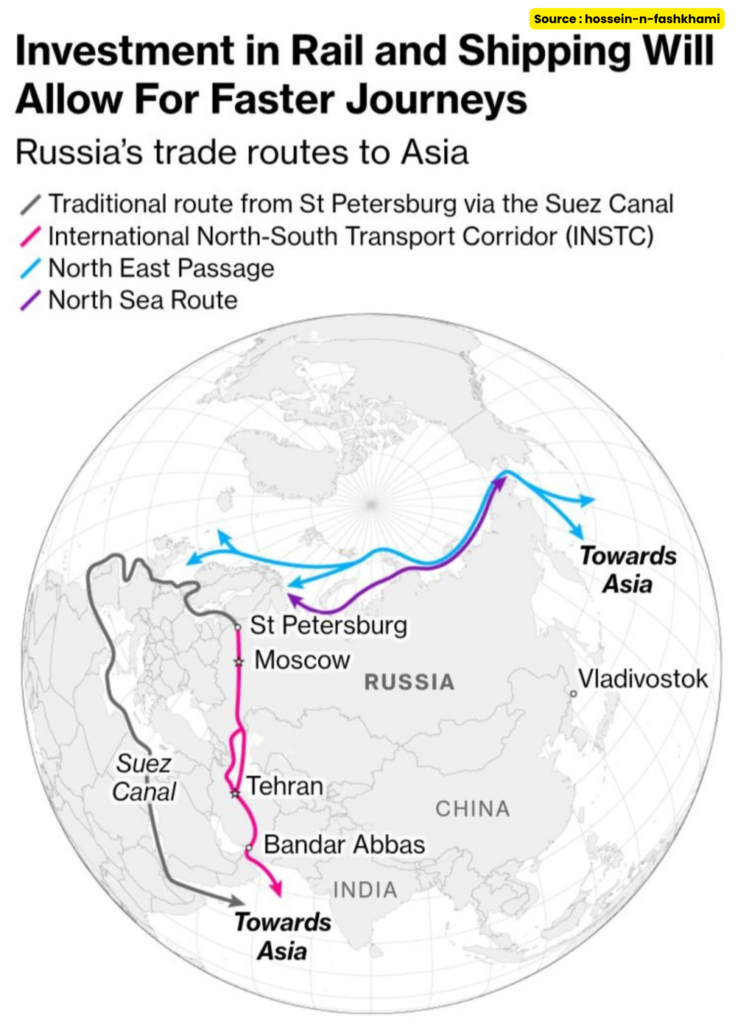Russia Seeks New Trade Road: Building Asian Trade Routes to Bypass Sanctions

20th April 2024
Report : Russia exploring new trade routes across Asia
Russia is making new trade routes through Asia, aiming to lessen the economic blow of sanctions imposed over its war in Ukraine. These routes, including a revamped rail network via Iran and an Arctic sea passage, hold the potential to reshape global trade flows and solidify Russia’s economic ties with Asian powerhouses like China and India.
The traditional trade route between Europe and Asia, the Suez Canal, is facing increasing security concerns. Houthi rebel attacks on international shipping in the Red Sea, fueled by the ongoing Israeli-Palestinian conflict, are prompting businesses to seek alternative paths.
Russia’s proposed routes offer a potential solution. The revamped rail network, partially funded by a 1.3 billion euro loan Russia extended to Iran last year, will create a vital missing link. This 162-kilometer stretch will connect the Iranian city of Rasht on the Caspian Sea coast to Astara on the border with Azerbaijan. Upon completion, this railway will allow cargo to flow seamlessly from St. Petersburg in Russia all the way to Bandar Abbas, Iran’s main export port on the Persian Gulf.

This route, combined with the development of an Arctic sea passage, dubbed the Northern Sea Route (NSR), could significantly impact global trade. The NSR offers a shorter transit time between Europe and Asia compared to the Suez Canal, potentially slashing travel times by 30-50%. Additionally, the NSR bypasses the security vulnerabilities of the Red Sea.
This pivot towards Asia isn’t entirely new. Russia has long sought to diversify its trade partnerships, and China has emerged as a crucial economically. The current geopolitical climate has only accelerated this shift. With Western sanctions impacting its traditional European markets, Russia is looking East for new opportunities.
Also Read : Indian Refiners Return to Iraq as Russia Loses Grip on Top Supplier Spot
The success of these new routes, however, hinges on several factors. The NSR remains a challenging route, with harsh weather conditions and limited infrastructure. Developing the necessary ports and navigation technology will be a costly and time-consuming endeavor. Additionally, political instability in the region surrounding the Iranian rail network could pose security concerns.
Despite these challenges, the potential benefits for Russia are significant. A successful pivot towards Asia could help mitigate the impact of sanctions and create new economic partnerships. For China and India, these new routes offer faster and more secure transportation options, potentially boosting trade with Europe.
The long-term impact of Russia’s Asian trade push remains to be seen. However, one thing is clear: the global trade landscape is undergoing a significant shift, with Russia at the center of this evolving dynamic. The success of its Asian ambitions could reshape the flow of goods and redraw the map of global economic influence.
Conclusion
Russia’s pursuit of a new Asian trade route is a strategic response to Western sanctions. While the potential benefits are undeniable, the path forward is fraught with challenges. The success of this strategy will depend on Russia’s ability to overcome infrastructure hurdles, navigate complex geopolitical landscapes, and manage its evolving relationship with China. Only time will tell if Russia’s New Silk Road ambitions can deliver the economic resilience it desperately seeks.
Also Read : Houthi rebels Escalate Conflict: Leader Claims Operations in Indian Ocean
Click here to join our Telegram chanel
You will get information, news, and support related to Merchant Navy.
